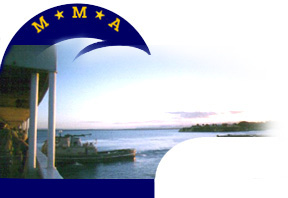
Captain's Log for Saturday, 12 February 2000
|
As of 0700 Eastern Standard time, 1200 GMT and 1100 ship time, the Empire State was underway from Barcelona, Spain and enroute to Buzzards Bay, Massachusetts. She was located at 33 degrees 50 minutes North Latitude, 032 degrees 11 minutes West Longitude, steering course 250 degrees true at 16 knots. That position puts her approximately 500 nautical miles south southwerst of the island of Flores, Acores. The weather was cloudy with winds out of the northeast at 6 knots. Barometric pressure was 1035 millibars. The air temperature was 62 degrees and the sea water temperature was 68 degrees. The depth of water beneath the keel was 2000 fathoms. The ship is riding OK on moderate northeasterly swells.
CAPTAIN'S LOG For those of you plotting our position, you will notice that we have altered course to port and have gone south about 180 miles. We saw a storm moving toward us from the East Coast and thought we would duck under it. There are purists who think we shouldn't shield our young cadets from the raw savagery of the deep ocean in winter, but our primary mission is training. To intentionally proceed into North Atlantic storms in mid-winter strikes me as practicing "bleeding" for a first-aid course. There are better ways to train. Besides, tomorrow will be our first (and last) real "Sunday-at-Sea": a day of rest and celebration for almost everyone aboard. I wanted a nice day for the event, but I'll talk more about that tomorrow. Saturday is a normal workday aboard this ship so today we put the Bridge teams through their paces. "MAN OVERBOARD, STARBOARD SIDE!!" was the call that went up just after the 12 to 1600 watch was posted. Cadets on the rail could see that some dummy had fallen over the side and seemed to be struggling in the boiling water of the big ship's wake. "RIGHT FULL RUDDER!" shouted the Cadet Officer of the Watch to the freshman on the helm. Lunch plates, casually stacked after lunch, crashed to the deck as the ship leaned into the turn and cut a white curve into the clear blue surface of the ocean. Lookouts on the bow and stern had their arms fully extended, pointing earnestly at the hapless soul that was being left farther and farther behind the fast moving vessel. Liferings arced from the bridge wing, splashing too far from their target. Tensions were high on the Bridge. The Radar Operator and Navigator worked furiously to annotate the ARPA radar screen and fix the ship's position on the GPS (Global Positioning System). Radio calls were made over the VHF, the engineroom was placed on standby and the Captain was notified as the helmsman spun the ship's wheel from side to side. Emergency alarms blared throughout the ship, adding to the stress as the "Oscar" flag was hoisted on the halyard and the ready boat crew made their way to the rescue lifeboat. All happening in no particular order- just as long as they happened FAST. The lookouts, well trained ashore in the Fall semester, never took their eyes off of the bobbing target, never let their arms waiver or their accusatory fingers stray from the now small speck in the wake. They were always there, providing a reference bearing for the Cadet Officer of the Watch whenever she looked up from her other duties to see if her actions were taking the ship back for a rescue, or dooming the man overboard to a visit with the dreaded "Davey Jones". After a perfect Williamson turn, Empire State glided to a stop right next to the dummy in the water - and the old survival suit, nicknamed "Oscar", was plucked from the sea. "OK everyone, nice job. Now let's do it again." Most mariners are familiar with the "Williamson Turn". Developed by a naval officer many years ago, it requires the deck officer to change the compass direction and manipulate the engines in a very specific order. The result? The ship will always stop exactly at the spot where the turn began . We expect this method to be selected when the person falls overboard during night time or restricted visibility. Another choice for similar conditions is relatively new. Called the "Scharnow Turn", it differs in that stopping the engines may be postponed and the ship can arrive at the scene quicker since you will be following the reciprocal of the original track. Under circumstances when the exact time of the casualty is not known, but can be estimated, the choice might be a "Race Track Turn" where the ship is turned 180 degrees, proceeds back along the opposite heading for a determined amount of time, then turned 180 degrees again. The ship will now be on the original track and a look-out search can begin. The last choice is the quickest, but requires good visibility. The "Round Turn", preferably involving a left, 360 degree turn, will bring the ship quickly back, full circle, to the beginning point. Choices, choices. What's the new Cadet officer of the Watch going to do this time? Time to get back to work. 'See you tomorrow from the leisure of a Sunday at sea.
|
|
||||||||||||||||||||||||||||||||||||||||||||||||||